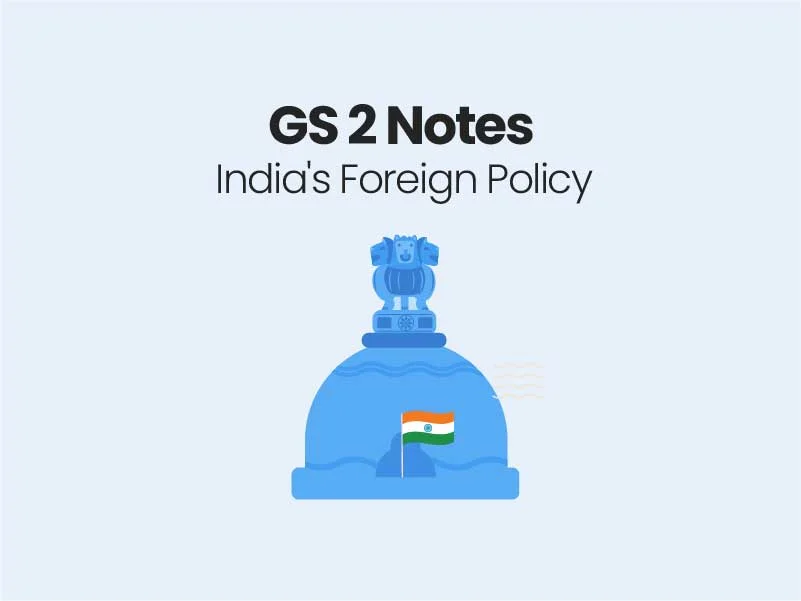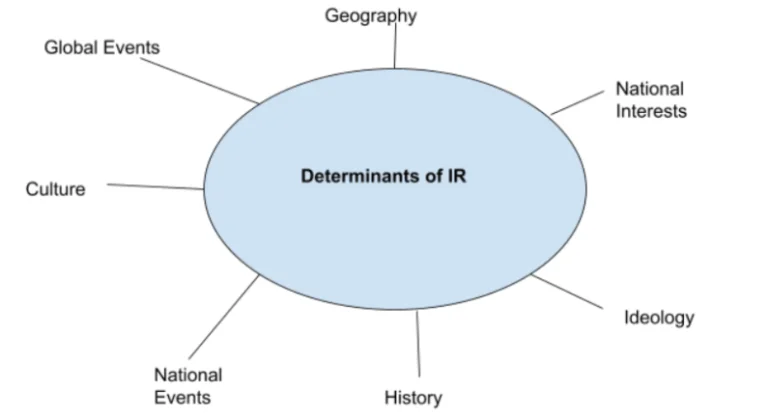
India’s Foreign Policy – Determinants
India’s foreign policy is shaped by five broad factors viz. geography; Ideology; National Interests Historical Factors, National events, Global Events, Culture.

Indian Foreign Policy Evolution
Foreign policy of any country, unlike domestic policy, is usually considered to be staid and stable, not subject to revolutionary change. Foreign policy is both static and dynamic.
Pre-Independence Era
- Throughout ancient and medieval times, we had cordial relationships with the globe’s people. Throughout pre-colonial history, India’s flourishing empires also made significant cultural and academic developments.
- With the establishment of British colonialism in India, its external relation particularly with neighbouring countries was mainly shaped by colonial motives.
Foreign Policy of Independent India:
ERA OF OPTIMISTIC NONALIGNMENT (1947-62)
- Creation of the Non-Aligned Movement (NAM) when the nations met in Belgrade Serbia in 1961.
- Non-alignment is not a policy of nonintervention or neutrality as it is commonly misunderstood. It was a policy of not joining either of the cold war camps: The Western World or the USSR led Warsaw Pact
- It meant providing issue based support to these nations on which the nations belonging to the NAM could benefit from:
- This phase to be one that involved idealism in foreign policy.
- This period soon ended when the Chinese handed over a humiliating defeat to the Indians in the Sino-Indian war of 1962. India was rudely shaken up after this event.

ERA OF REALISM AND DISCOVERY (1962-70)
- During this phase, it continued leading the NAM grouping and embraced Afro-Asian solidarity.
- Pakistan and China also united and further attempted to weaken India.
- The relations with the US too deteriorated after the tenure of President John F Kennedy. The US insisted that India join the US and become a part of the cold war politics. India steadfastly refused and the US denied India food aid.
- The economic situation too suffered with stagnant agriculture. It was under these circumstances that the Green Revolution was launched.
- Massive inflation eroded the confidence in the Indian rupee and overall, these eight years which saw three Prime Ministers was an era where realism returned and India began to discover its friends and foes.
ERA OF REGIONAL ASSERTION (1971- 1991)
- The next 20 years saw India emerging as a regional power within South Asia. It began with the victory against Pakistan in the 1971 war wherein Bangladesh was created out of East Pakistan.
- India also asserted its regional influence in the Tamil civil war in Sri Lanka
- Relation with Pakistan and China began to improve during Rajiv Gandhi Tenure
- India emerged as a regional power in the conduct of its diplomacy.
QUEST FOR STRATEGIC AUTONOMY (1991- 1999)
- The collapse of the USSR in 1991 dealt a huge blow to the aspirations of the Indian foreign policy. The USSR acted as a guiding force of India from the 1960’s and their collapse, once again brought forth the quest for strategic autonomy.
- However, amidst all these developments, it was important for India to maintain its strategic autonomy. Despite massive international pressure, the government headed by Atal Bihari Vajpayee conducted the Pokhran nuclear tests in 1998.
- Strategic autonomy denotes the ability of a state to pursue its national interests and adopt its preferred foreign policy without being constrained in any manner by other states.
BALANCING POWER (2000-2013)
- The 21st century began with the signing of the Indo-Russia Special and Privileged Relationship Treaty 2000.
- The visit of the US President George W Bush in 2006 which led to the signing of the Indo-US Nuclear deal truly signalled the beginning of a strategic partnership with the US.
- Relationships with China improved whereas Japan, South Korea, and ASEAN became closer to India.
ENERGETIC DIPLOMACY (2014-PRESENT)
- Indian foreign policy is becoming assertive and India is no more a nation that is dependent on external powers for its development.
This is an India that is Aatmanirbhar but also at the same time, it embraces globalization and is standing up to bullies in the region (China), standing shoulder to shoulder with the global powers, and is on the verge of ascendancy.

Principles and Doctrines of India
Panchsheel Principle
- The guiding principles of India’s Foreign Policy have been founded on Panchsheel, pragmatism and pursuit of national interest. The five principles of peaceful coexistence or Panchsheel was evolved during talks between India and the People’s Republic of China in 1954. The five principles which formed the basis of the non aligned movement were laid down by Jawaharlal Nehru.
- The Five Principles are:
- Mutual respect for each other’s territorial integrity and sovereignty
- Mutual non-aggression against anyone
- Mutual non-interference in each other’s internal affair
- Equality and mutual benefit
- Peaceful co-existence
Gujral Doctrine
- The Gujral Doctrine is a set of five principles to guide the conduct of foreign relations with India’s immediate neighbours.
- These five principles arise from the belief that India’s stature and strength cannot be isolated from the quality of its relations with its neighbours.
- It, thus, recognises the supreme importance of friendly, cordial relations with neighbours.
- It helped in the formation of Neighbourhood First Policy
- These principles are:
- With neighbours like Bangladesh, Bhutan, Maldives, Nepal and Sri Lanka, India does not ask for reciprocity but gives and accommodates what it can in good faith and trust.
- No South Asian country should allow its territory to be used against the interest of another country of the region.
- No country should interfere in the internal affairs of another.
- All South Asian countries must reach each other’s territorial integrity and sovereignty.
- They should settle all their disputes through peaceful bilateral negotiations.
SAGAR Vision
- In 2015, India unveiled it’s strategic vision for the Indian Ocean i.e. Security and Growth for All in the Region (SAGAR). It is an increasing recognition of the increasing importance of maritime security, maritime commons and cooperation.
- Through SAGAR, India seeks to deepen economic and security cooperation with its maritime neighbours and assist in building their maritime security capabilities. For this, India would cooperate on the exchange of information, coastal surveillance, building of infrastructure and strengthening their capabilities.
- Further, India seeks to safeguard its national interests and ensure the Indian Ocean region to become inclusive, and collaborative and respects international law.
Act East Policy
- The ‘Act East Policy’ announced in November 2014 is the upgrade of the “Look East Policy”.
- It is a diplomatic initiative to promote economic, strategic and cultural relations with the vast Asia-Pacific region at different levels.
- It involves intensive and continuous engagement with Southeast Asian countries in the field of connectivity, trade, culture, defence and people-to-people-contact at bilateral, regional and multilateral levels.
It aims to promote economic cooperation, cultural ties and develop a strategic relationship with countries in the Indo-Pacific region with a proactive and pragmatic approach and thereby improving the economic development of the North Eastern Region (NER) which is a gateway to the South East Asia Region.
Read All GS Notes
Enroll today with the best civils service academy and take your first step towards your Civils journey.
Feel free to reach out to us for any inquiries, collaborations, or support. We’re here to help.

